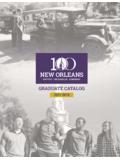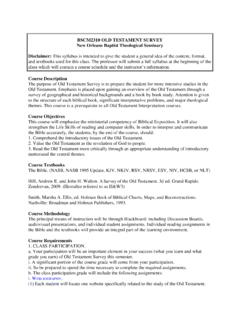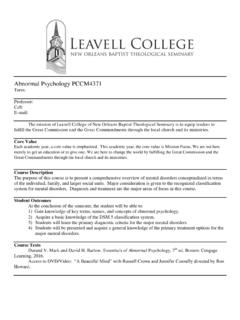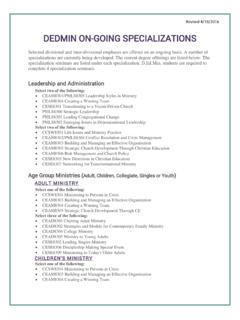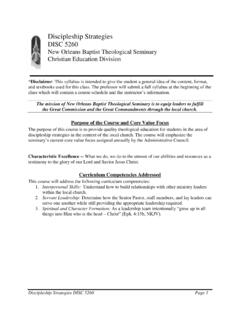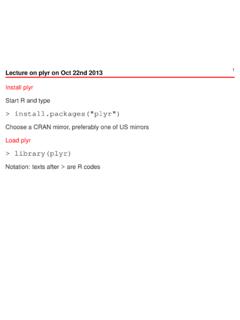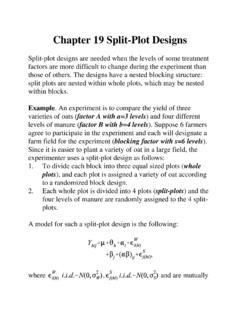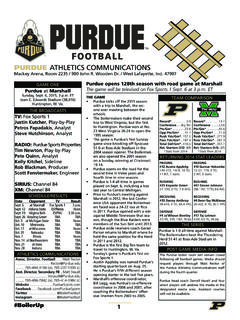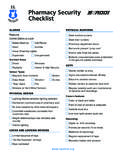Transcription of Welcome to the Purdue OWL - NOBTS
1 Welcome to the Purdue OWL This page is brought to you by the OWL at Purdue ( ). When printing this page, you must include the entire legal notice at bottom. Contributors:Geoff Stacks, Erin Karper, Dana Bisignani, Allen Brizee. Summary: This handout provides information about annotated bibliographies in .. CMS1. Annotated Bibliographies Definitions A bibliography is a list of sources (books, journals, Web sites, periodicals, etc.) one has used for researching a topic. Bibliographies are sometimes called "References" or "Works Cited" depending on the style format you are using. A bibliography usually just includes the bibliographic information ( , the author, title, publisher, etc.)
2 An annotation is a summary and/or evaluation. Therefore, an annotated bibliography includes a summary and/or evaluation of each of the sources. Depending on your project or the assignment, your annotations may do one or more of the following. Summarize: Some annotations merely summarize the source. What are the main arguments? What is the point of this book or article? What topics are covered? If someone asked what this article/book is about, what would you say? The length of your annotations will determine how detailed your summary is. For more help, see our handout on paraphrasing sources. Assess: After summarizing a source, it may be helpful to evaluate it. Is it a useful source?
3 How does it compare with other sources in your bibliography? Is the information reliable? Is this source biased or objective? What is the goal of this source? For more help, see our handouts on evaluating resources. Reflect: Once you've summarized and assessed a source, you need to ask how it fits into your research. Was this source helpful to you? How does it help you shape your 1. CMS is an abbreviation for the Chicago Manual of Style. Turabian is based on CMS. argument? How can you use this source in your research project? Has it changed how you think about your topic? Your annotated bibliography may include some of these, all of these, or even others.
4 If you're doing this for a class, you should get specific guidelines from your instructor. Why should I write an annotated bibliography? To learn about your topic: Writing an annotated bibliography is excellent preparation for a research project. Just collecting sources for a bibliography is useful, but when you have to write annotations for each source, you're forced to read each source more carefully. You begin to read more critically instead of just collecting information. At the professional level, annotated bibliographies allow you to see what has been done in the literature and where your own research or scholarship can fit. To help you formulate a thesis: Every good research paper is an argument.
5 The purpose of research is to state and support a thesis. So a very important part of research is developing a thesis that is debatable, interesting, and current. Writing an annotated bibliography can help you gain a good perspective on what is being said about your topic. By reading and responding to a variety of sources on a topic, you'll start to see what the issues are, what people are arguing about, and you'll then be able to develop your own point of view. To help other researchers: Extensive and scholarly annotated bibliographies are sometimes published. They provide a comprehensive overview of everything important that has been and is being said about that topic. You may not ever get your annotated bibliography published, but as a researcher, you might want to look for one that has been published about your topic.
6 Format The format of an annotated bibliography can vary, so if you're doing one for a class, it's important to ask for specific guidelines. The bibliographic information: Generally, though, the bibliographic information of the source (the title, author, publisher, date, etc.) .. The annotations: The annotations for each source are written in paragraph form. The lengths of the annotations can vary significantly from a couple of sentences to a couple of pages. The length will depend on the purpose. If you're just writing summaries of your sources, the annotations may not be very long. However, if you are writing an extensive analysis of each source, you'll need more space. You can focus your annotations for your own needs.
7 A few sentences of general summary followed by several sentences of how you can fit the work into your larger paper or project can serve you well when you go to draft. Contributors:Geoff Stacks, Erin Karper, Dana Bisignani, Allen Brizee. Summary: This handout provides information about annotated bibliographies in .. CMS. Annotated Bibliography Example Elizabeth Thompson Professor Stacks English 102 20 August 2016 Stem Cell Research: An Annotated Bibliography Holland, Suzanne. The Human Embryonic Stem Cell Debate: Science, Ethics, and Public Policy. Boston: MIT P, 2001. This is the annotation of the above source, which is formatted according to MLA 2016 (8th ed.) guidelines for the bibliographic information listed above.
8 If one were really writing an annotation for this source, one would offer a brief summary of what this book says about stem cell research. After a brief summary, it would be appropriate to assess this source and offer some criticisms of it. Does it seem like a reliable and current source? Why? Is the research biased or objective? Are the facts well documented? Who is the author? Is she qualified in this subject? Is this source scholarly, popular, some of both? The length of your annotation will depend on the assignment or on the purpose of your annotated bibliography. After summarizing and assessing, you can now reflect on this source. How does it fit into your research? Is this a helpful resource?
9 Too scholarly? Not scholarly enough? Too general/specific? Since "stem cell research" is a very broad topic, has this source helped you to narrow your topic? Senior, K. "Extending the Ethical Boundaries of Stem Cell Research." Trends in Molecular Medicine, vol. 7, 2001, pp. 5-6. Not all annotations have to be the same length. For example, this source is a very short scholarly article. It may only take a sentence or two to summarize. Even if you are using a book, you should only focus on the sections that relate to your topic. Not all annotated bibliographies assess and reflect; some merely summarize. That may not be the most helpful for you, but, if this is an assignment, you should always ask your instructor for specific guidelines.
10 Wallace, Kelly. "Bush Stands Pat on Stem Cell Policy." CNN. 13 Aug. 2001. Using a variety of sources can help give you a broader picture of what is being said about your topic. You may want to investigate how scholarly sources are treating this topic differently than more popular sources. But again, if your assignment is to only use scholarly sources, then you will probably want to avoid magazines and popular web sites. The bibliographic information above is proper MLA format (use whatever style is appropriate in your field) and the annotations are in paragraph form. Note also that the entries are alphabetized by the first word in the bibliographic entry. If you are writing an annotated bibliography with many sources, it may be helpful to divide the sources into categories.
